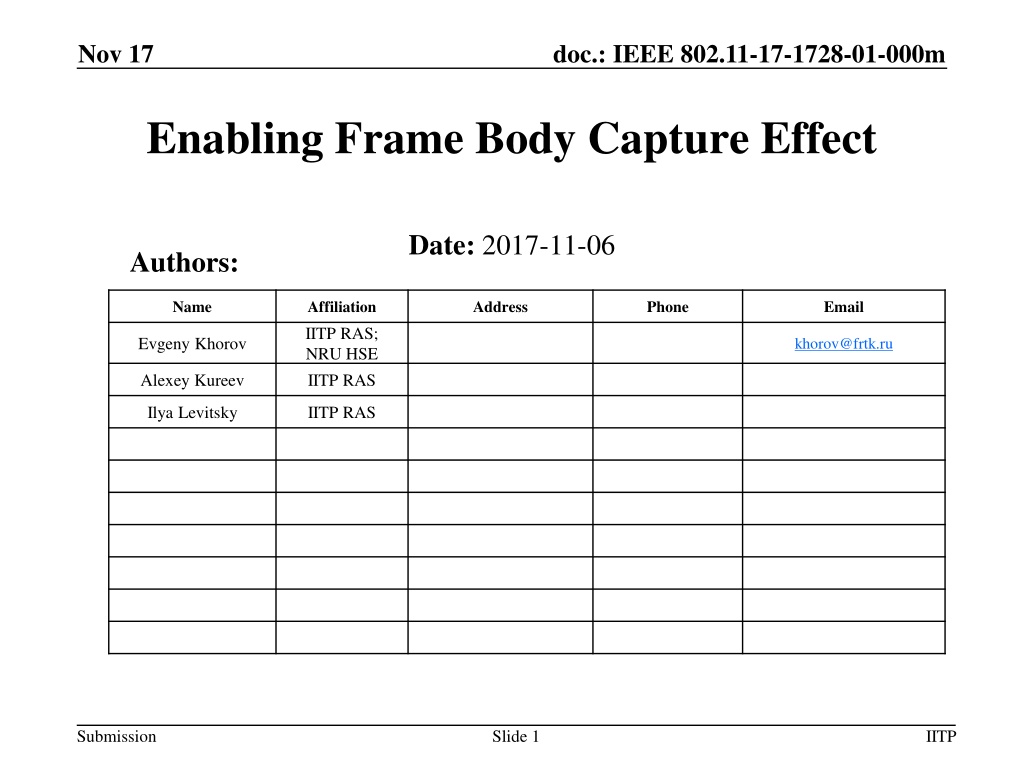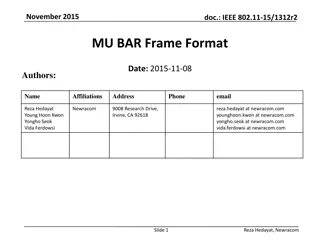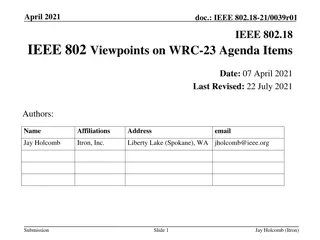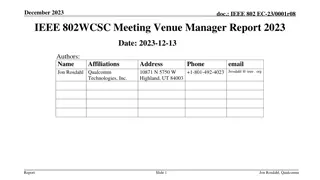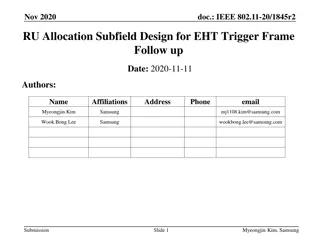IEEE 802.11-17-1728-01-000m: Frame Body Capture Effect Study
Examining the impact of frame overlap in wireless networks during dense deployment scenarios, where stronger frames interfere with weaker ones, resulting in potential data loss and synchronization issues. Testbed evaluations reveal challenges and consequences of frame capture effects on standard compliance.
Uploaded on Sep 29, 2024 | 0 Views
Download Presentation

Please find below an Image/Link to download the presentation.
The content on the website is provided AS IS for your information and personal use only. It may not be sold, licensed, or shared on other websites without obtaining consent from the author. Download presentation by click this link. If you encounter any issues during the download, it is possible that the publisher has removed the file from their server.
E N D
Presentation Transcript
Nov 17 doc.: IEEE 802.11-17-1728-01-000m Enabling Frame Body Capture Effect Date: 2017-11-06 Authors: Name Affiliation IITP RAS; NRU HSE IITP RAS Address Phone Email Evgeny Khorov khorov@frtk.ru Alexey Kureev Ilya Levitsky IITP RAS Submission Slide 1 IITP
Nov 17 doc.: IEEE 802.11-17-1728-01-000m Problem In dense deployment, it may happen that a stronger frame from own BSS arrives when a STA is already synched to a weaker frame (e.g. from an alien BSS) Power time Submission Slide 2 IITP
Nov 17 doc.: IEEE 802.11-17-1728-01-000m Receive State Machine (DSSS PHY) In the event that a change in PHYCS or PHYED would cause the status of CCA to return to the IDLE state before the complete reception of the MPDU, as indicated by the PHY LENGTH field, the error condition shall be reported to the MAC using a PHY- RXEND.indication(CarrierLost) primitive. The CCA of the DSSS PHY shall indicate a busy medium for the intended duration of the transmitted packet. Submission Slide 3 IITP
Nov 17 doc.: IEEE 802.11-17-1728-01-000m Receive State Machine (OFDM) Submission Slide 4 IITP
Nov 17 doc.: IEEE 802.11-17-1728-01-000m Receive State Machine (11ax) The same happens here Submission Slide 5 IITP
Nov 17 doc.: IEEE 802.11-17-1728-01-000m Consequences Power time In this case, both frames will be lost: The green one will be lost because of huge interference The red lime will be lost because the receiving STA was synched to the green frame However, at least red frames could be received Submission Slide 6 IITP
Nov 17 doc.: IEEE 802.11-17-1728-01-000m Testbed We evaluated behavior of off-the-shelf devices in this scenario with the following testbed Submission Slide 7 IITP
Nov 17 doc.: IEEE 802.11-17-1728-01-000m Frame Body Capture Effect IS NOT Present Frame receive ratio Both frames are lost Submission Slide 8 IITP
Nov 17 doc.: IEEE 802.11-17-1728-01-000m Frame Body Capture Effect Is Present Stronger frame is correctly received Frame receive ratio This is not aligned to the standard Submission Slide 9 IITP
Nov 17 doc.: IEEE 802.11-17-1728-01-000m Real Devices Analyses Vendors and Device names are hidden Some devices support the feature Submission Slide 10 IITP
Nov 17 doc.: IEEE 802.11-17-1728-01-000m Conclusion Allowing switching to a stronger frame is fruitful since give an opportunity to a STA to receive at least one frame in case of overlapped frames. This feature is currently implemented in some devices. This feature is not allowed by the standard. We need to allow this feature. In case of a stronger frame arrive, a STA may switch to this frame, operating as if the weaker frame were not received. Submission Slide 11 IITP
Nov 17 doc.: IEEE 802.11-17-1728-01-000m Straw Poll Do you agree that 802.11 should allow switching to a stronger frame during frame body of a weaker one Y N A Submission Slide 12 IITP
Nov 17 doc.: IEEE 802.11-17-1728-01-000m Motion - Do you agree to add the following para to the end of Sections 15.3.7, 16.2.6, 17.3.12, 19.3.21, 20.9, 21.3.20, 23.3.19 (all entitled PHY receive procedure )? It may happen that several frames overlap and a stronger frame starts later than the weaker one. To allow reception of at least the stronger frame, at any state of the PHY receive state machine, the STA can perform detection of a new frame start and switch to a new frame with higher power. Y N A Submission Slide 13 IITP
